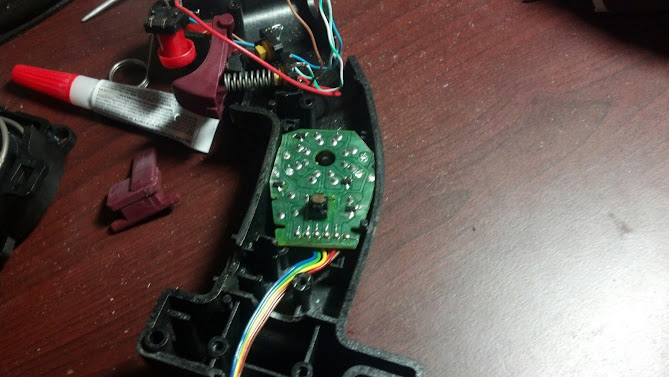Quote
Yeah I should have taken a picture.
Yes, yes you should have.

...heh, taking pics is usually the part that hangs up a lot of what I want to do. By the time I'm actually working on stuff, due to my small space and overabundance of stuff it's hard to take pics without backgrounds that clutter the foreground into uselessness, whether in my garage or apartment. Still though, cluttered pics are better than no pics!
*Ya know, there is one other solution that I haven't explored yet due to lack of necessity, but the easiest way to gain full control of a stick and have it work like a mouse is to gut a mouse and use it's optical sensor mated to the bottom of the gimbal. The 'mousepad' would be a small fixed compound curve section just big enough to allow the full travel of the optical sensor. I have been thinking about building such a stick for quite some time, but don't think I've mentioned it until now cause I always wanted to make it first and it slips my mind in the meantime. You could still use Teensy this way if you wanted, since it's only button mapping at that point, or other stuff that can be done in AHK etc, breaking the TARGET monopoly. If it's made with a nice gaming mouse, it would be super precise, have dual or better sensitivity, absolute inputs, enough buttons/hats to populate a nice stick and so on.
The whole exercise becomes a rather simplish mechanical affair focusing on the gimbal and it having the right length arms opposite the pivots in order to give the optical sensor the correct range of motion/travel and all attention can then be paid to making the axes move smooth with consistent damping, which was the third demon I had to slay (first being absolute inputs, second being zenith/azimuth gimbal). On that subject, I have abandoned springs for supplying the tension on the rubs on my stick, in favor of rubber cushions of various durometer. The advantages are noticeable on compact arrangements such as a gimbal, since it takes a lot less threaded portion of an axle shank to accommodate. I have found it easier to achieve more consistent/even loads at higher pressures too, so overall just works better and easier to implement in practice. The larger the surface area, the better it works (big *** fender washers are your friend!). The key to making all these tensioned rubs not just work, but work well and remain consistent over the wear of time is a small item, but a non negotiable one -the thrust bearing in between the tension nut and the washers/doughnuts. This relieves almost all load from that spot you don't want friction, and all relevant frictional forces then come from where you want -the greased plastic rubs being precisely squeezed.
Bravo on continued objective exploration. Sounds like your experiment started allowing your hand to finally get a peek at the possibilities too. As tio calibrating it, well that's a whole nother thing. With TARGET sticks, first thing when it's plugged in is running it through it's basic calibration process that establishes range of motion and centers on the pots,
then fire up the script. What's neat is it allows me to use different ranges of motion based on the mech, since without physical stops on my stick, it registers the stop as wherever I happen to stop it. Shorter stop = more sensitive since it uses less range of motion to generate full inputs and visa versa, but I think I'm digressing...
*mouse optical sensor hack as described was my fallback position last summer in case the Cougar bits weren't gonna work on my stick. The
original counterweight seen in pics 2-4 was built that way to potentially accommodate the sensor, putting it out far in both axes in order to maximize 'mousepad' surface area and hence precision, but after proper function was established made a more compact arrangement.
Edited by Loc Nar, 12 April 2013 - 12:37 PM.
 Loc Nar, on 03 April 2013 - 10:32 AM, said:
Loc Nar, on 03 April 2013 - 10:32 AM, said:




























